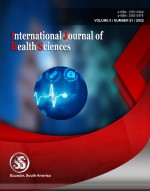Genetic polymorphisms in interleukin-1beta were associated with typhoid fever in Babylon City in Iraq
Keywords:
Babylon, infection, interleukin-1beta, typhoid feverAbstract
A total of 50 clinical samples were taken from the blood of typhoid fever patients who visited Al-Hillah Surgical Teaching Hospital and private laboratories in the AL-Hillah/Babylon region between February and August 2021. This research included 50 people who looked to be healthy and disease-free. Individuals with genotype GA were significantly represented among the patients with typhoid fever: 33 (66%), P-value = 0.0030, as compared with healthy control subjects, 18 (36%), and had an increased risk of developing typhoid fever infection. The IL-1beta (G) allele was less frequent among patients (51%, n =51) than control, and the (A) allele was more frequent among patients than control (49%, n =49). The results showed that there was a significant association between GA genotype and typhoid fever under most inheritance models. The A allele represents a risk factor for patients with typhoid fever and the inheritance of codominant, dominant, and overdominant models as risk factors. The GA genotype has an odd ratio of 4.07 (1.54–10.79) in the model of inheritance. Codominant and dominant models have a related odd ratio of 3.04 (1.21–7.60) and the overdominant model has a related odd ratio of 3.45 (1.52–7.85).
Downloads
References
Antillón, M.; Warren, J.; Crawford, F.; Weinberger, D. Kürüm, E.; Pak, G.; Marks, F. and Pitzer, V. (2017). The burden of typhoid fever in low and middle income countries: A meta-regression approach. PLoS neglected tropical diseases. 11(2), e0005376.
Pouzol, S.; Tanmoy, A.; Ahmed, D.; Khanam, F.; Brooks, W.; Bhuyan, G.; Fabre, L.; Bryant, J.; Gustin, M.; Vanhems, P.; Carman, B.; Weill, F.; Qadri, F.; Saha, S. and Endtz, H. (2019). Clinical evaluation of a multiplex PCR for the detection of Salmonella enterica serovars typhi and paratyphi A from blood specimens in a high endemic setting. Am. J. Trop. Med. Hyg. 101(3): 513-520.
Phetsavanh, C.; Mayfong, M.; Phouthapanya, X.; Tamalee, R.; Sayaphet, R.; Manivanh, V.; Paul, N. and John, A. (2020). Estimation of incidence of typhoid and paratyphoid fever in Vientiane, Lao People’s Democratic Republic. Am. J. Trop. Med. Hyg. 102(4), pp. 744-748.
Dinarello, C. (2006). Interleukin-1 and interleukin-18 as mediators of inflammation and the aging process. Am. J. Clin. Nutr. 83:447-455.
Ulaganathan, V. K.; Sperl, B.; Rapp, U. R. and Ullrich, A. (2015). Germline variant FGFR4 p. G388R exposes a membrane-proximal STAT3 binding site. Nature. 528(7583), 570-574.
Ishigame, H.; Kakuta, S.; Nagai, T.; Kadoki, M.; Nambu, A.; Komiyama, Y. and Sudo, K. (2009). Differential roles of interleukin-17A and-17F in host defense against mucoepithelial bacterial infection and allergic responses. Immunity. 30(1), 108-119.
Halle, A., Hornung; V., Petzold, G. C.; Stewart, C. R.; Monks, B. G.; Reinheckel, T.; Fitzgerald, K. A.; Latz, E.; Moore, K. J. and Golenbock, D. T. (2008). The NALP3 inflammasome is involved in the innate immune response to amyloid-beta. Nature immunology. 9(8), 857-865.
Estfanous, S., Ali, S. A., Seif, S. M., Soror, S., & Abdelaziz, D. (2019). Inflammasome genes' polymorphisms in egyptian chronic hepatitis C patients: Influence on vulnerability to infection and response to treatment. Mediators of inflammation. 3273645.
Pontillo, A.; Reis, E. C.; Liphaus, B. L.; Silva, C. A., and Carneiro-Sampaio, M. (2015). Inflammasome polymorphisms in juvenile systemic lupus erythematosus. Autoimmunity. 48(7), 434.437.
Ali, S.; Vollaard, A. M.; Kremer, D.; de Visser, A. W.; Martina, C. A.; Widjaja, S.; Surjadi, C.; Slagboom, E.; van de Vosse, E. and van Dissel, J. T. (2007). Polymorphisms in proinflammatory genes and susceptibility to typhoid fever and paratyphoid fever. Journal of interferon & cytokine research : the official journal of the International Society for Interferon and Cytokine Research. 27(4), 271-279.
Park, J. W.; Choi, J. S.; Han, K. J.; Lee, S. H.; Kim, E. J. and Cho, J. H. (2018). Association of a genetic polymorphism of IL1RN with risk of acute pancreatitis in a Korean ethnic group. The Korean journal of internal medicine. 33(6), 1103-1110.
Ogimoto, A.; Suzuki, J. Inoue, K.; Nishimura,K.; Nagai, T. Shigematsu, Y.; H.; Okayama, and J. Higaki. (2018). Interaction between polymorphisms in inflammation-related genes and atrial fibrillation in patients with dilated cardiomyopathy. Circulation. 2011;124:A16747.
Reis, C., Barbosa, M., Machado, B., Baratto, S., de Lima, D. C., Paza, A. O., Filho, F. B., Brancher, J. A., Küchler, E. C., & de Oliveira, D. (2021). Genetic polymorphisms in interleukin-6 and interleukin-1-beta were associated with dental caries and gingivitis. Acta. Odontologica. Scandinavica. 79(2), 96-102.
Ersig, A. L.; Schutte, D. L.; Standley, J.; Leslie, E.; Zimmerman, B.; Kleiber, C.; Hanrahan, K.; Murray, J. C. and McCarthy, A. M. (2017). Relationship of genetic variants with procedural pain, anxiety, and distress in children. Biological research for nursing. 19(3), 339-349.
Published
How to Cite
Issue
Section
Copyright (c) 2022 International journal of health sciences

This work is licensed under a Creative Commons Attribution-NonCommercial-NoDerivatives 4.0 International License.
Articles published in the International Journal of Health Sciences (IJHS) are available under Creative Commons Attribution Non-Commercial No Derivatives Licence (CC BY-NC-ND 4.0). Authors retain copyright in their work and grant IJHS right of first publication under CC BY-NC-ND 4.0. Users have the right to read, download, copy, distribute, print, search, or link to the full texts of articles in this journal, and to use them for any other lawful purpose.
Articles published in IJHS can be copied, communicated and shared in their published form for non-commercial purposes provided full attribution is given to the author and the journal. Authors are able to enter into separate, additional contractual arrangements for the non-exclusive distribution of the journal's published version of the work (e.g., post it to an institutional repository or publish it in a book), with an acknowledgment of its initial publication in this journal.
This copyright notice applies to articles published in IJHS volumes 4 onwards. Please read about the copyright notices for previous volumes under Journal History.
















